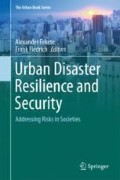Abstract
The USA operates and maintains a vast array of critical infrastructure (CI), from energy and water systems to transportation systems and communication nodes. Operating and maintaining this CI is a complex challenge, particularly as infrastructure continues to age and overall investments continue to decline. It is within this context that resilience is discussed. The roots of resilience in the USA go back for decades with a focus on disaster mitigation of infrastructure damage, developing plans and procedures, assessing vulnerabilities, hardening systems, building in redundancies, etc.; as well as developing standards, policies, and technologies for this purpose. The USA has a history of responding well in times of crisis, including national mobilization during the World War II and steps taken following the terrorist attacks of 9/11. The US formally recognized resilience in national doctrine with the issuance of the 2010 National Security Strategy, which states that we must enhance our resilience—that is, our ability to adapt to changing conditions and prepare for, withstand, and rapidly recover from disruption (Obama in National security strategy of the United States, The White House, Washington, DC, 2010). Resilience policy has existed in various forms in other domains; however, this official declaration of strategy broadened the terminology to national security and helped reframe the focus. The US resilience focus is moving from a myopic physical security posture to a holistic resilience framework. Several key programs are increasing US CI resilience.
References
Blake ES, Landsea CW (2011) The deadliest, costliest, and most intense United States tropical cyclones from 1851 to 2010 (and other frequently requested hurricane facts) (Tech. No. NWS NHC-6). National Hurricane Center, Miami, FL
Brown KA (2006) Critical path. A brief history of critical infrastructure protection in the United States. Spectrum Publishing Group, Inc, Fairfax, Virginia
Bush GW (2003) Homeland security presidential directive/HSPD-7: critical infrastructure identification, prioritization, and protection (United States). White House Office of the Press Secretary, Washington, DC
Cacioppo JT (2010, March) Build Your Social Resilience. Retrieved November 15, 2016, from https://www.psychologytoday.com/blog/connections/201003/build-your-social-resilience
City of Oakland (2016) Resilient Oakland: it takes a town to thrive. Retrieved from https://beta.oaklandca.gov/documents/resilient-oakland-strategy
Clinton WJ (1996) Executive order 13010—critical infrastructure protection, Online by Gerhard Peters and John T. Woolley, The American presidency project. Retrieved from http://www.presidency.ucsb.edu/ws/?pid=53066
Comptroller General of the United States (1979) Report to congress. Key crude oil and product pipelines are vulnerable to disruptions, (Government Accounting Office, EMD-79–63), Washington, DC
Fisher RE, Bassett GW, Buehring WA, Collins, MJ, Dickinson DC, Eaton LK … Millier DJ (2010) Constructing a resilience index for the enhanced critical in infrastructure protection program (No. ANL/DIS-10–9). Argonne National Laboratory (ANL)
Fisher RE, Norman MA (2010) Constructing a protective measures index across the security spectrum. J Business Continuity Emergency Plann (in press)
Fisher RE (2012) Taking a normative approach to organizational culture change on critical infrastructure protection, Benedictine University, Doctor of Philosophy in Organization Development, Lisle, IL
Lesar DJ (2001) Securing oil and natural gas infrastructures in the new economy. National Petroleum Council, Washington, DC
Meserve J (2007, September) Sources: staged cyber attack reveals vulnerability in power grid. Retrieved November 15, 2016, from http://www.cnn.com/2007/US/09/26/power.at.risk/index.html?_s=PM:US
National Council on Public Works Improvement (1988) Fragile foundations: a report on America’s public works: final report to the president and the congress. The Council, Washington, DC
Obama BH (2010) National security strategy of the United States. The White House, Washington, DC
Obama BH (2011) Presidential policy Directive 8: National Preparedness, (PPD-8) [Press Release] The White House, Office of the Press Secretary. Retrieved from https://www.dhs.gov/xlibrary/assets/presidential-policy-directive-8-national-preparedness.pdf
Obama BH (2013) Presidential policy directive 21: critical infrastructure security and resilience (PPD-21) [Press Release]. The White House, Office of the Press Secretary. Retrieved from https://www.whitehouse.gov/the-press-office/2013/02/12/presidential-policy-directive-critical-infrastructure-security-and-resil
Perrow C (2007, July) Disasters evermore? Inside risks. Retrieved December 2, 2016, from: http://www.csl.sri.com/users/neumann/insiderisks07.html#205
Resilience in action, early insights into how cities are institutionalizing resilience (2016, October). Retrieved December 2, 2016, from The Rockefeller Foundation website http://www.100resilientcities.org/page/content/resilience-in-action#/-_/
Rinaldi SM, Peerenboom JP, Kelly TK (2001) Identifying, understanding, and analyzing critical infrastructure interdependencies. Control Systems, 21(6):11–25, IEEE
Terzich C, Moran T (2014) Member and mission landscape study, RC3 regional consortium coordinating council
United States. Congress. Senate. Committee on Governmental Affairs (1989) Vulnerability of telecommunications and energy resources to terrorism hearings before the Committee on Governmental Affairs, United States Senate, One Hundred First Congress, first session, February 7–8, 1989. Washington: U.S. G.P.O.: For sale by the Supt. of Docs., Congressional Sales Office, U.S. G.P.O
United States, Department Of Energy. Office of Critical Infrastructure Protection (2001) Critical infrastructure interdependencies: impact of the September 11 Terrorist Attacks on the World Trade Center A Case Study, p 10
United States, Department of Homeland Security (2009) National infrastructure protection plan: partnering to enhance protection and resiliency. U.S. Dept. of Homeland Security, Washington, DC
United States, Department of Homeland Security (2016, August) Regional Resilience Assessment Program (RRAP) Fact Sheet. Retrieved December 2, 2016, from https://www.dhs.gov/publication/rrap-fact-sheet
Author information
Authors and Affiliations
Corresponding author
Editor information
Editors and Affiliations
Rights and permissions
Copyright information
© 2018 Springer International Publishing AG
About this chapter
Cite this chapter
Fisher, R., Norman, M., Peerenboom, J. (2018). Resilience History and Focus in the USA. In: Fekete, A., Fiedrich, F. (eds) Urban Disaster Resilience and Security. The Urban Book Series. Springer, Cham. https://doi.org/10.1007/978-3-319-68606-6_7
Download citation
DOI: https://doi.org/10.1007/978-3-319-68606-6_7
Published:
Publisher Name: Springer, Cham
Print ISBN: 978-3-319-68605-9
Online ISBN: 978-3-319-68606-6
eBook Packages: Earth and Environmental ScienceEarth and Environmental Science (R0)

